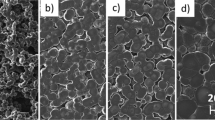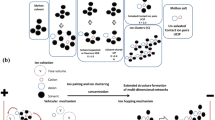Abstract
WHEN the principle of mass action is applied to explain the effect on the electrical properties of certain electronic semi-conductors having an ionic lattice structure, produced by varying the vapour pressure of one of the constituents of the substance, it is found that nf = KPυ1/n, (1) where nf is the concentration of charge carriers, which may be free electrons or holes, K is an equilibrium constant, Pυ is the vapour pressure, and n is a constant, negative for excess and positive for defect semi-conductors, which can be deduced from the chemical structure of the substance.
This is a preview of subscription content, access via your institution
Access options
Subscribe to this journal
Receive 51 print issues and online access
$199.00 per year
only $3.90 per issue
Buy this article
- Purchase on Springer Link
- Instant access to full article PDF
Prices may be subject to local taxes which are calculated during checkout
Similar content being viewed by others
References
Seitz, F., "The Modern Theory of Solids" (McGraw-Hill, New York, 1940).
Dünwald, H., and Wagner, C., Z. phys. Chem., B, 22, 212 (1933).
von Baumbach, H. H., and Wagner, C., Z. phys. Chem., B, 24, 59 (1934).
von Baumbach, H. H., and Wagner, C., Z. phys. Chem., B, 22, 199 (1933).
Wagner, C., Z. phys. Chem., B, 22, 195 (1933).
Author information
Authors and Affiliations
Rights and permissions
About this article
Cite this article
HOGARTH, C. Variation of Thermo-electric Power of Electronic Semi-Conductors with Vapour Pressure. Nature 161, 60–61 (1948). https://doi.org/10.1038/161060b0
Issue Date:
DOI: https://doi.org/10.1038/161060b0
Comments
By submitting a comment you agree to abide by our Terms and Community Guidelines. If you find something abusive or that does not comply with our terms or guidelines please flag it as inappropriate.



